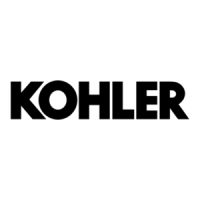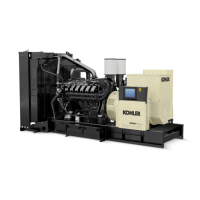What causes fuel filter restriction in a Kohler Portable Generator?
- KKevin TannerAug 5, 2025
A fuel filter restriction can be caused by a dirty filter. Clean or replace the fuel filter.

What causes fuel filter restriction in a Kohler Portable Generator?
A fuel filter restriction can be caused by a dirty filter. Clean or replace the fuel filter.
What to do if my Kohler Portable Generator runs out of fuel?
If your Kohler Portable Generator runs out of fuel, add fuel to the tank and ensure the fuel valve is in the ON position.
How to fix engine overload on my Kohler Portable Generator?
To fix an engine overload on your Kohler Portable Generator, reduce the electrical load you're placing on the generator.
What to do if the coolant level is low in my Kohler Portable Generator?
If the coolant level is low, restore the coolant to the normal operating level.
How to fix an exhaust system leak on a Kohler Portable Generator?
If there's an exhaust system leak, inspect the exhaust system and replace any damaged or deteriorated components.
What to do if the exhaust system is not securely installed on my Kohler Portable Generator?
If the exhaust system is not securely installed, inspect the exhaust system and tighten any loose components.
What to do if the controller fuse is blown on my Kohler Portable Generator?
If the controller fuse is blown, check for battery power to the controller and replace the fuse.
Procedures to prevent unintended generator set startup and disable the unit.
Hazards and precautions related to battery handling, acid, and explosion risks.
Risks and precautions regarding engine backfire and fuel fires.
Safety information related to the generator exhaust system and carbon monoxide.
Hazards and precautions for handling fuel and fuel systems, including vapors.
Risks associated with generator set noise levels and hearing protection.
Dangers of electrical shock and injury from moving parts.
Safety precautions for lifting and handling heavy generator set components.
Warnings about hot engine, exhaust, coolant, and alternator components.
Technical specifications for the generator set controller.
Key features and capabilities of the generator set controller.
Details on connecting various modules and external devices to the controller.
Controller functions monitored to meet NFPA 110, Level 1 requirements.
Factory-set parameters for the generator set controller.
Factory settings for base module digital and analog inputs/outputs.
Essential checks to perform before starting the generator set.
Procedures for operating the generator set under load weekly.
Procedures for starting, stopping, and cooling down the generator set.
Description of Auto, Manual, and Out of Service modes for controller operation.
Functionality for automatically disconnecting non-critical loads.
Controller's display of status, alarm, and fault messages.
Viewing and understanding generator set status messages, alarms, and faults.
Procedure for clearing active alarms after resolving the condition.
Procedure for resetting generator set faults after correcting the cause.
Schedule for engine and generator set maintenance tasks.
Essential engine maintenance tasks and references.
Procedures for fuel system maintenance, including filters and bleeding.
Procedures for engine oil changes and analysis.
Procedures for cooling system maintenance, checks, and refills.
Information and maintenance procedures for generator set batteries.
Maintenance procedures for alternators and voltage regulators.
Safety precautions related to hot coolant and steam.
Hazards and precautions related to battery handling and service.
Safety precautions for working on alternators and electrical systems.
Safety precautions for generator set storage.
Troubleshooting specific to the generator set and its controller.
Troubleshooting procedures for the engine.
A chart listing common problems, causes, and recommended actions.











